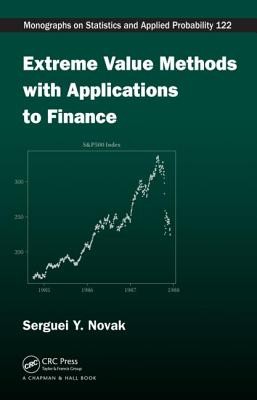
- Išsiųsime per 10–14 d.d.
- Autorius: Serguei Y Novak
- Leidėjas: CRC Press
- ISBN-10: 1439835748
- ISBN-13: 9781439835746
- Formatas: 15.6 x 23.4 x 2.2 cm, kieti viršeliai
- Kalba: Anglų
- Extra -15 % nuolaida šiai knygai su kodu: ENG15
Extreme Value Methods with Applications to Finance + nemokamas atvežimas! | knygos.lt
Atsiliepimai
Aprašymas
Extreme value theory (EVT) deals with extreme (rare) events, which are sometimes reported as outliers. Certain textbooks encourage readers to remove outliers-in other words, to correct reality if it does not fit the model. Recognizing that any model is only an approximation of reality, statisticians are eager to extract information about unknown distribution making as few assumptions as possible.
Extreme Value Methods with Applications to Finance concentrates on modern topics in EVT, such as processes of exceedances, compound Poisson approximation, Poisson cluster approximation, and nonparametric estimation methods. These topics have not been fully focused on in other books on extremes. In addition, the book covers:
- Extremes in samples of random size
- Methods of estimating extreme quantiles and tail probabilities
- Self-normalized sums of random variables
- Measures of market risk
Along with examples from finance and insurance to illustrate the methods, Extreme Value Methods with Applications to Finance includes over 200 exercises, making it useful as a reference book, self-study tool, or comprehensive course text.
A systematic background to a rapidly growing branch of modern Probability and Statistics: extreme value theory for stationary sequences of random variables.
EXTRA 15 % nuolaida su kodu: ENG15
Akcija baigiasi už 3d.02:12:22
Nuolaidos kodas galioja perkant nuo 10 €. Nuolaidos nesumuojamos.

- Autorius: Serguei Y Novak
- Leidėjas: CRC Press
- ISBN-10: 1439835748
- ISBN-13: 9781439835746
- Formatas: 15.6 x 23.4 x 2.2 cm, kieti viršeliai
- Kalba: Anglų
Extreme value theory (EVT) deals with extreme (rare) events, which are sometimes reported as outliers. Certain textbooks encourage readers to remove outliers-in other words, to correct reality if it does not fit the model. Recognizing that any model is only an approximation of reality, statisticians are eager to extract information about unknown distribution making as few assumptions as possible.
Extreme Value Methods with Applications to Finance concentrates on modern topics in EVT, such as processes of exceedances, compound Poisson approximation, Poisson cluster approximation, and nonparametric estimation methods. These topics have not been fully focused on in other books on extremes. In addition, the book covers:
- Extremes in samples of random size
- Methods of estimating extreme quantiles and tail probabilities
- Self-normalized sums of random variables
- Measures of market risk
Along with examples from finance and insurance to illustrate the methods, Extreme Value Methods with Applications to Finance includes over 200 exercises, making it useful as a reference book, self-study tool, or comprehensive course text.
A systematic background to a rapidly growing branch of modern Probability and Statistics: extreme value theory for stationary sequences of random variables.




Atsiliepimai